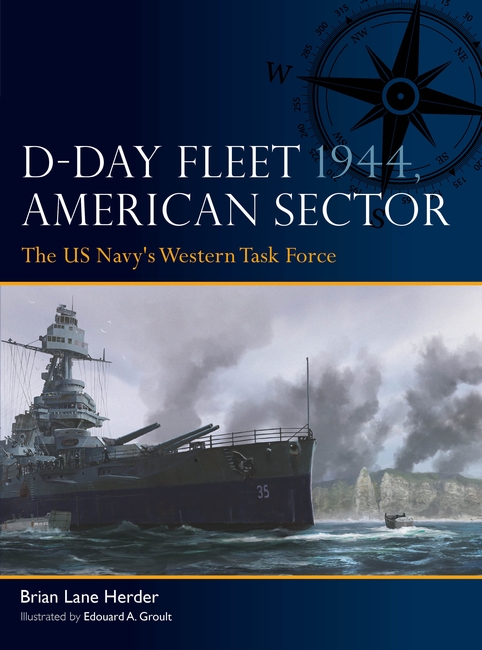
The invasion begins
Force U’s 16 Task Groups had loaded in nine different ports before assembling into 12 convoys to make the crossing, while Force O’s 13 Task Groups had loaded in five different ports and assembled into five convoys. Usually, each convoy was made up of three or four sections of similar type or speed, most of which had to rendezvous at sea. Most LCTs, LCMs, and Rhino ferries either crossed the stormy Channel under their own power or were towed, with only LCVPs and LCAs typically being piggybacked aboard motherships. Although Force U had been badly disorganized by the postponement, Force O would cross with little problem. The battleships and cruisers of the WNTF sortied from Belfast, with most of their escorting destroyers joining them en route. Accompanying Hall’s Force O to Omaha was the cruiser Augusta, the overall WNTF flagship carrying Rear Admiral Kirk and Lieutenant-General Bradley.
All five Neptune invasion forces, converging from the far reaches of the United Kingdom, were channeled into and through a previously swept circular zone south of the Isle of Wight officially designated Area Zebra but inevitably dubbed “Piccadilly Circus.” Galley fires were put out at midnight, June 6, and all ships went to General Quarters and set watertight doors to the maximum setting of Condition Zebra.
“The mine,” Ramsay had observed, “is our greatest obstacle to success.” Neptune had assigned the minesweepers three sequential missions: to provide a safe passage for the assault forces to the transport area; to provide wider channels to the beaches for shipping in the buildup; and finally, to sweep a channel parallel to the beaches, which would be continuously broadened until it would form a safe anchorage and patrol area.
During the night of June 5–6, each minesweeper flotilla closed on the Normandy coast for four hours before reversing course along a parallel track. Small vessels followed behind the minesweepers, deploying floating red/green danbuoys to mark the swept channel edges. The minesweepers worked in groups of six, steaming in echelon the breadth of the desired channel. However, on the evening of June 5, Mine Squadron 7’s USS Osprey (AM-56) struck a mine that started fires and ripped open its forward engine room. At 1815hrs, Osprey’s skipper, Commander Henry Plander, ordered his ship abandoned. The burning Osprey sank shortly afterwards, having lost six men, the first casualties of Overlord.
Despite Osprey’s loss, at 0200hrs on June 6 the minesweepers began sweeping the transport area, approach areas, fire support area, and the boat lanes to within a mile of the French coast. The minesweepers would sweep two separate channels to each of Utah and Omaha – a fast 12-knot channel for attack transports and destroyers, and a slow 5-knot channel for landing craft. Once the Utah and Omaha channels had been swept and marked, the outbound minesweepers began sweeping the Utah and Omaha anchorage areas 11–12nm offshore, dedicated to the large attack transports.
At 2215hrs on June 5, some 925 C-47 transport planes of the US Ninth Air Force had begun launching from 25 airfields in western England. By 0130hrs on June 6, they would start dropping 13,000 paratroopers of the US 82nd and 101st Airborne Divisions at six designated drop zones behind Utah. Darkness, weather, and German anti-aircraft fire caused most drops to be badly scattered and 60 percent of their equipment to be lost. German defenders alerted LXXXIV Korps headquarters at 0215hrs on June 6, but Wehrmacht commanders appeared to believe the airborne landings were merely diversionary to the assumed main landings at the Pas-de-Calais.
A force of 36 U-boats based at Brest, L’Orient, Saint-Nazaire, and La Pallice had been assigned to counterattack any cross-Channel invasion fleet. An additional three German destroyers from Royan had also been forward-deployed to Brest. After German radar detected the invasion fleet, a Kriegsmarine alert was sounded at 0309hrs on June 6. Nevertheless, only 15 S-boats sortied, and these aborted because of the weather without ever sighting the Neptune invasion fleet. Indeed, the Kriegsmarine’s U-boats, destroyers, and S-boats all proved “no-shows” on D-Day. According to Nevada’s Captain Powell Rhea: “It was astounding, and certainly more than could be hoped for, to have been able to make the approach and anchor … [so close to] the enemy beaches completely unopposed.”
You can read more in D-Day Fleet 1944, American Sector: The US Navy's Western Task Force

Comments
You must be logged in to comment on this post. Click here to log in.
Submit your comment